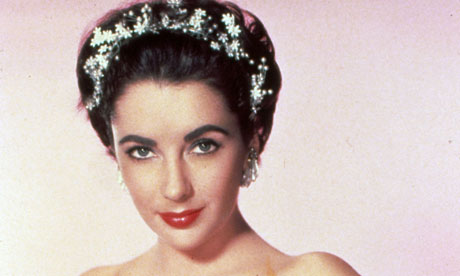
I speak to you as one who has every biography of Elizabeth Taylor ever published neatly arrayed on her bookshelves and thoroughly read. They are in my Hollywood film section, which also comprises juicy, glittering hardbacks full of juicy, glittering facts – or, far more likely, factoids and outright, fabulous lies – about the lives of Bette Davis, Joan Crawford, James Dean, Montgomery Clift and all the glorious rest of them, and the even-more-fabulously-ridiculous autobiographies of gossip-column queens Hedda Hopper and Sheilah Graham. Louella Parsons' is literally in the post.
So (apart from the fact that I will go to my grave regretting that I did not manage to buy one of the six-volume catalogues that accompanied the sale at Christie's last year) I'm afraid I couldn't have been happier last night, luxuriating in Elizabeth Taylor: The Auction of a Lifetime (Channel 4), which took a suitably decadent one-and-a-half hours to tell the story of MGM's mightiest, shiniest, most unabashedly acquisitive star through the sale of the jewellery collection she amassed. The programme, the jewels, the story were altogether – as Richard Burton, notoriously Taylor's fifth and sixth husband, once said of his ungovernable inamorata – too bloody much, which was just as it should be.
Every piece came with an insane price tag (only their intrinsic value was given in the catalogue. The "Elizabeth Taylor premium", as Francois Curiel, one of the Christie's auctioneers explained, was incalculable). Thus, the $60,000 starting price for the tiara third husband Mike Todd bought her, worn to the 1957 Oscars, went up to $3.7m and set the tone for the day and a perfectly illustrative vignette of Taylor's eternal appeal. This involved the diamond earrings Todd had made secretly to replace the paste ones Elizabeth fell in love with during one of their early trips to Paris. She wore them, as we saw in an archive clip, to a Hollywood party along with a wholly undisguised tracheotomy dressing at her throat, and you couldn't say which became her more.
Bulgari coloured diamonds, emeralds from everywhere, sapphires and endless carats from Cartier rained down. And just when you thought things couldn't get any more thrillingly lush or absurd, the Richard Burton years began. The Krupp diamond was slipped on to the finger of his beloved and known from then on as the Taylor-Burton diamond. Even here she got top billing. She never took the ring off, said Robert Hardy, and it was filthy. When he paid a visit to her in hospital, he cleaned it in the sink with hot water and gin. Ward Landrigan, the then head of Sotheby's New York jewellery department, reminisced about bringing the Peregrina Pearl, given by Philip of Spain to Mary Tudor and handed down after her death through generations of Spanish queens, to Elizabeth after Burton bought it for her in 1969. She lost it in the pink shag-pile of her hotel room within 20 minutes. The three of them crawled round looking for it – only two of them, one suspects, laughing.
Taylor's penchant for jewellery wasn't about avarice, but about mere acquisition. They were prices exacted for the pleasure of knowing that she could, and tributes gladly paid by men in the presence of a beauty so incredible that she was probably the only woman in the world who has ever added lustre to the pieces she wore, rather than the other way around.
The collection sold for $135m in the end. It was all disgustingly decadent, entirely morally unconscionable and the most fun I've had in ages.
From a film worshipping the celluloid goddess of the 1950s it is but a short hop, skip and jump in one way and a long, long journey in another to Bettany Hughes' Divine Women (BBC2), a series about the lost evidence of women's centrality to early religions. Last night's episode explored the history of the priestess, from the poet Sappho channelling Aphrodite in ancient Greece and the spectacularly unfortunate Vestal Virgins of ancient Rome to the rabidly unhelpful development of the doctrine of original sin by Augustine (later Saint Augustine, for his trouble) after which women – the apple-bearing instigators of it all – were pretty much done for as a spiritual force.
Compared with, say, Tuesday night's Meet the Romans with Mary Beard, Divine Women feels a little bit dry and clunky. Hughes is more often required to elicit from experts information that she must surely know herself, rather than being allowed to display her knowledge directly, which is slightly wearisome (and ironic, given the subject matter). But it is still a fascinating story, and well-enough told. Not as fascinating as a pair of divine Bulgari coloured diamond drop earrings, of course, but then what is?

